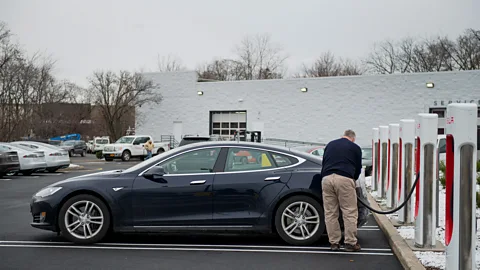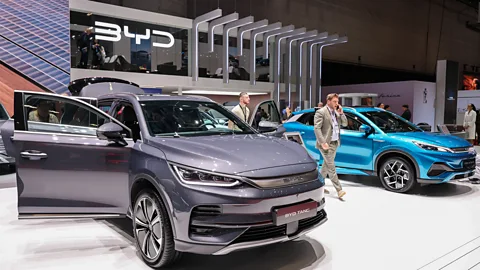EVs were once luxury vehicles. Now, they're for every driver
 Alamy
AlamyOnly a few years ago, electric vehicles were the domain of the wealthy. As prices fall, and more average drivers adopt them, they're no longer synonymous with status.
When the Roadster first rolled off Tesla's California assembly line in 2008, it was an instant sensation.
With a top speed of 130 miles per hour, zero-to-60 acceleration in four seconds and a sleek body, the two-seater electric vehicle embodied the luxury of a Mercedes, Porsche or Jaguar. In a Time magazine review, the Roadster was described as "a hot sports car that also doubled as a statement against pollution".
"Before Tesla, most people's experiences with an EV would be a golf cart or something," says Jeremy Micalek, professor of engineering and public policy at Carnegie Mellon University, US. "There was a sense of it being a small, slow vehicle where you have to compromise a lot." But Tesla's cars changed North Americans' perceptions of the EV market. Instead of that compromise, it became a status symbol. Its price was also a statement, with Roadster models starting at $98,950 (£77,375) – leaving it to the domain of the wealthy.
Tesla may have elevated the perception of EV through splashy, luxury vehicles – but today, many North American drivers hungry to adopt EVs amid a growing market aren't looking for a status symbol. They're looking for a deal. Automakers are answering the call: they've brought electric cars to market that prioritise affordably over luxury, knocking the EV off its pedestal.
At first, largely for the elite
Although it was always meant to signal status, Tesla's nearly six-figure Roadster wasn't necessarily priced to be deliberately out of reach for the large majority of drivers. James Carter, principal consultant at Canada-based electric vehicle consultancy Vision Mobility, says the price of the car was to cover the costs of EV technology – which was quite high more than a decade ago.
 Getty Images
Getty ImagesThe company did introduce slightly lower-priced models; the Model S, a five-door sedan, first produced in 2012, had a base price of $60,890 (£47,615). Still, its cost left it squarely out of reach for most consumers, who paid roughly $25,000 (£19,550) on average for a new car at the time.
EVs were also difficult to charge at the beginning, and had far lower ranges compared to today. The first wave of sales went to wealthy early adopters, says Micalek, who were willing to take a leap of faith on new automobile technology and had the money to keep an internal combustion engine car around for long trips.
But even though Tesla dominated the market share and became synonymous with EVs, something else was happening in the background: other automakers were pushing back on the idea of EV as a status symbol, instead striving to bring the average driver an accessible option that would lead to higher adoption rates.
More like this:
The Nissan Leaf – an all-electric subcompact car that first hit showrooms in 2010 – actually beat the Tesla into the North American market. While it didn't take off with quite the same panache or grab the same market share as Tesla, it hinted at the EV's future as an accessible car: "Leaf" was an acronym for "Leading Environmentally friendly Affordable Family". It still wasn’t cheap at $32,780 (£25,638) – but it began to enable non-luxury drivers to access EVs. Today, as EV technology becomes cheaper and cheaper, companies are increasingly focused on rolling out EVs at competitive price points.
The new EVs on the block
The trend of price-over-status EVs hitting the market is not only continuing, but spiking, especially as production costs come down. There are still plenty of high-priced, luxury-focused EVs on the market: Tesla retains its focus on serving the high-end consumer, for instance; and GMC's six-figure Hummer made a splash in 2021. Yet these EVs find themselves increasingly in the minority.
"When you look at the price evolution over the last seven years, you can see the cost of the batteries has come down significantly," says Werner Antweiler, chair of international trade policy at the University of British Columbia's Sauder School of Business, Canada. Batteries still aren't at what Antweiler calls "price parity" with ICE engines, but they're getting closer than they were before, enabling automakers to lower prices for eager consumers.
Governments in Europe and North America are also trying to nudge drivers towards EVs with cost incentives, often in the form of rebates. The US federal government, for instance, offers a base tax credit up to $7,500 (£5,865) for a new electric or plug-in hybrid, with some states and even local jurisdictions offering subsidies on top of that. Some countries, including Canada, have even announced phase-outs of gasoline-powered cars over the next decade or so.
Programmes like these, which aim to bring more EVs on the road for the average driver, are eroding the idea of EVs as the domain of the elite.
A Chinese EV shake-up?
Another major shift in the EV market may deliver the blow that fully knocks EVs from their pedestal. Chinese EV manufacturers are gearing up to enter this new market – with prices that simply can't be beat.
 Getty Images
Getty ImagesAs Teslas were hitting the road in the US, Chinese company BYD started in the mid-1990s manufacturing cell phone batteries, eventually supplying the likes of Nokia and Motorola. In 2005, it launched its first EV, the F3 subcompact, at a shockingly low price for any North American cars: the equivalent of about $10,000 (£7,818). The F3 was everything the Tesla Roadster was not: small, lightweight, no-frills and cheap. China does have luxury EV manufacturers, which sell EVs with substantially higher price tags; and BYD also has plans to make high-end models. But what's largely on the market is highly affordable.
In China, this widespread affordability has enabled EVs to mainstream – and feel like any other car on the road. Simply, in the Chinese market, owning an EV simply isn't all that special, says Helveston. "There are many major cities where one in five cars that you might see on the road are electric. This is just normal," he says.
Part of the reason why EVs have become so commonplace, however, doesn't just come down to consumer preferences. Local authorities, in an attempt to curb China's pollution problem, have put policies in place to encourage drivers to go EV. In Beijing, for example, drivers can only get a licence plate by lottery, and the total number of licence plates awarded each month is capped. But Helveston says there's a separate lottery, with far better odds, for EVs specifically.
With such low prices – and a good charging infrastructure that the US is trying to match through both public and private initiatives – these attitudes on EVs may serve as a harbinger for a shifting perspective in North America. The hope for automakers is EV will become just another car – especially as extremely low-priced Chinese EVs make their way across the ocean.
Eventually, EVs for everyone
Alongside the lower-cost EVs other automakers are introducing, Chinese EVs could represent a tipping point. Yet experts caution models by BYD and other Chinese EV manufacturers may not hit the market immediately.
While the Chinese firm started selling some of its models in Mexico last year, and currently produces them in Europe, Helveston says North America will be a tough market to penetrate. The US currently charges a 25% tariff on Chinese EV imports, which eats into the signature selling feature of these cars: affordability. US President Joe Biden also recently announced an investigation into the sale of Chinese EVs in the US on "national security" grounds, while Energy Secretary Jennifer Granholm said she is worried about China's ability to flood the US market.
"There are plenty of barriers here that are going to make it really hard," says Helveston. "Either they're going to have to import the cars, which is going to make them too expensive, or they're going to have to set up shop here, which is going to be really hard to do."
Ultimately, sales are going up and prices are going down – which means EVs no longer carry the cachet they once did. As the cost of batteries drops, automakers are getting close to the point where their EV offerings match their petrol-guzzlers. There will still be a market for luxury EVs, just like there is a market for luxury ICE vehicles. Yet they will be the exception, not the norm.
Carter is confident EVs will eventually get to a critical mass. Petrol isn't getting any cheaper, and electrification policies will ensure that owning an EV is simply the most affordable option. "By 2030," he says, "people without much money who can stretch themselves for a new car will only be buying EV."
